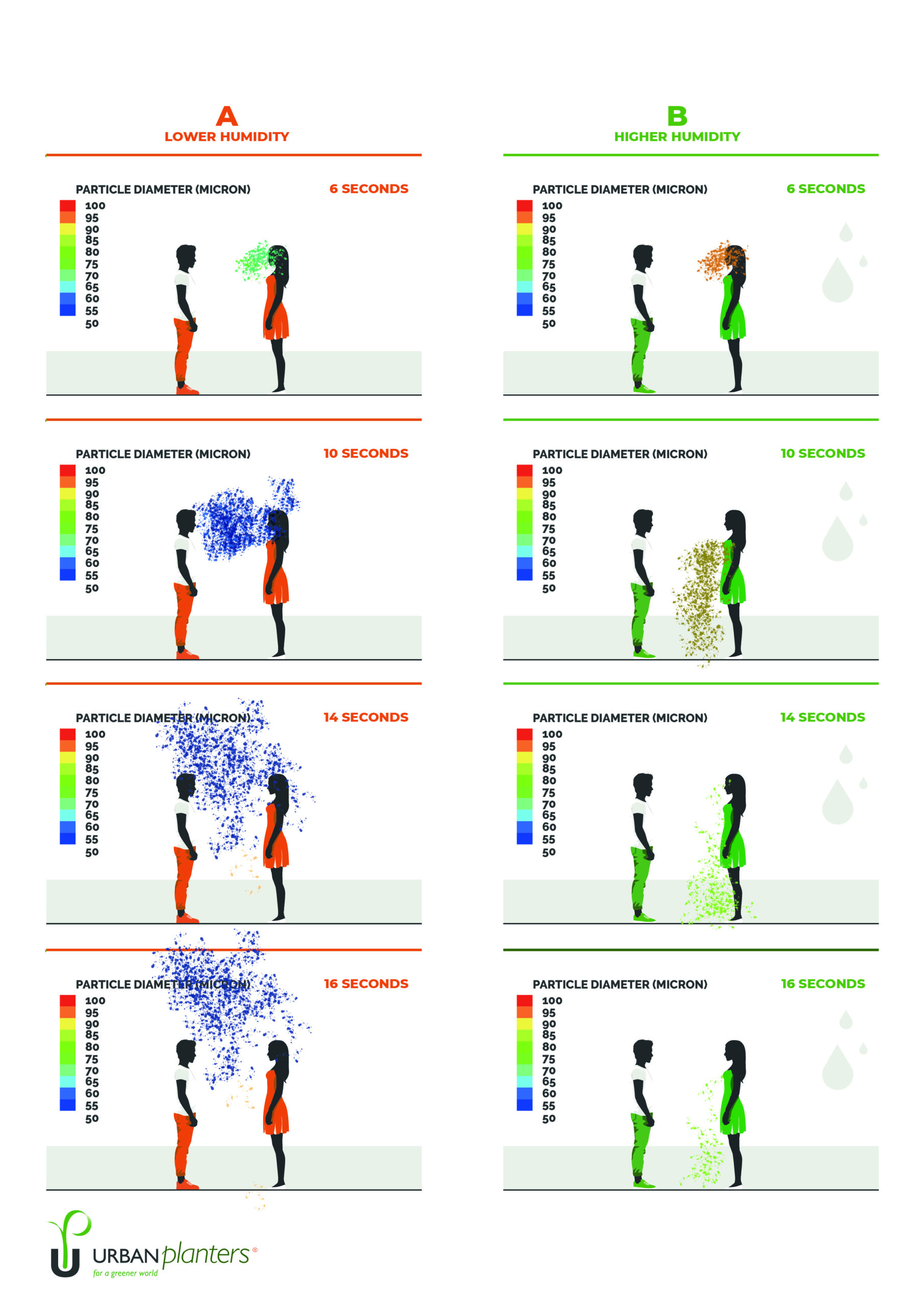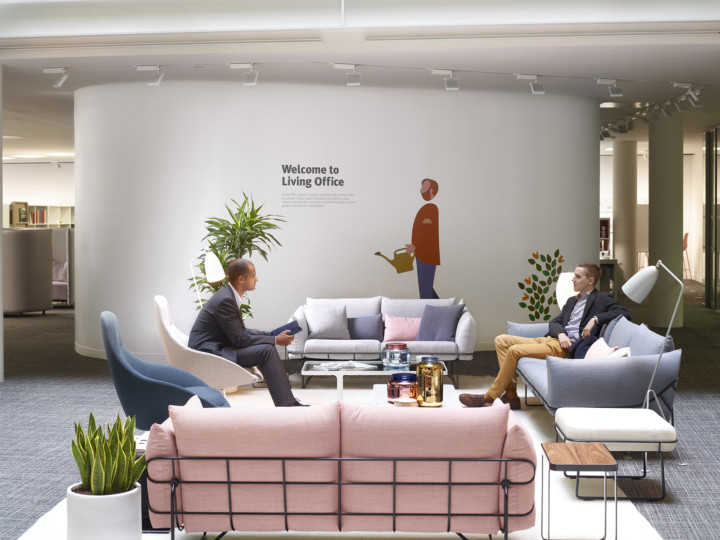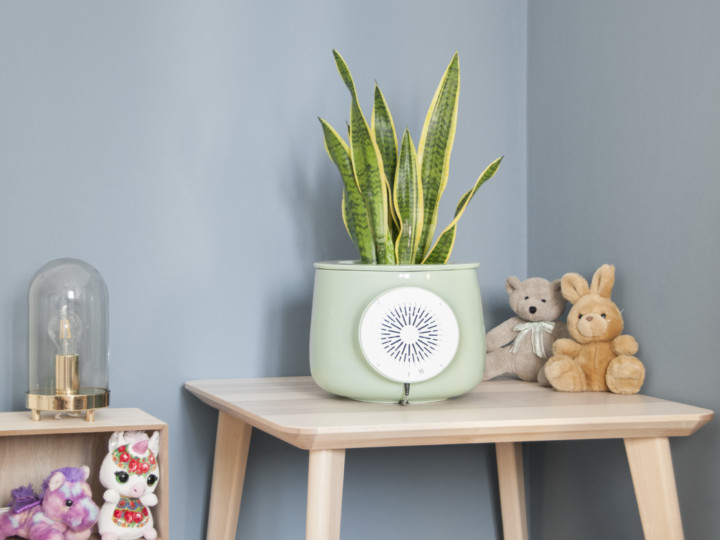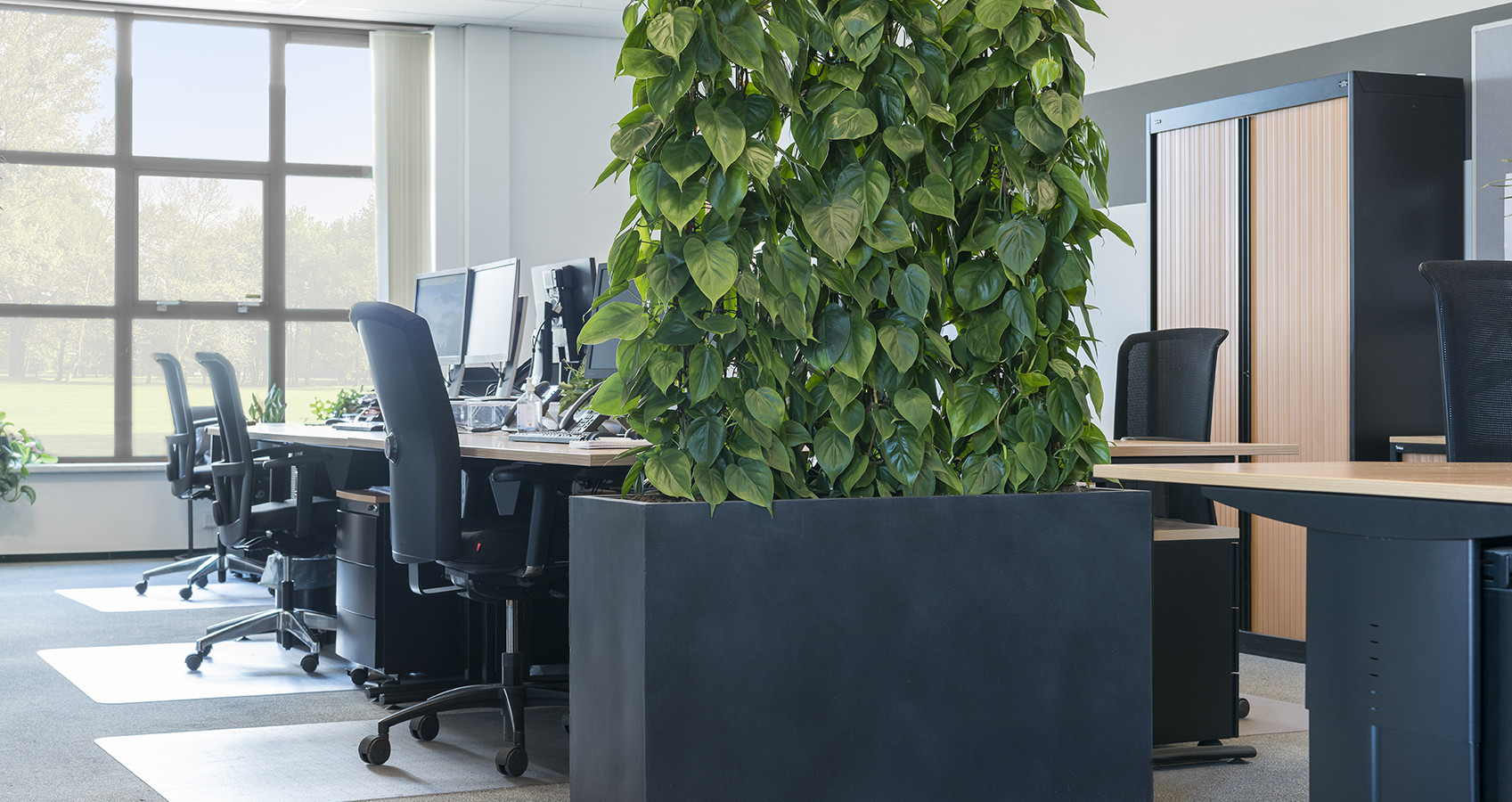
As we all adapt to what everyone is now calling the ‘new normal’, we find ourselves reviewing our workplaces and considering what adaptions are needed so we can all meet the government’s guidance on social distancing to keep ourselves and our workforce safe from Covid-19.
Now we all have the challenge of creating space within our workplaces for our employees and other users of the space to work and collaborate with each other without the risk of catching or spreading the coronavirus. This will no doubt be much more of a challenge for some than it will be for others.
When we assessed our own workspaces here within Urban Planters, we started to consider how our own plant and moss products could be integrated as a possible solution to help us to achieve a safe working environment for our workforce. The results were very encouraging, and we were pleased to discover that plant and moss displays work very effectively to help partition areas within the office. Effectively, they act as healthy, green, physical barriers to users of the workspace to keep a healthy distance from others in a way that looks and feels, well, natural.
The result is this new guide to how plants can help us keep apart without feeling imposing or clinical.
To take one simple solution as an example, we have planting containers that are 1m in length, so these can be easily used in pairs to help demarcate areas at 2m distances. They can also be used to create one-way systems within the workspace, or to partition off large open areas to form smaller, yet functional, private meeting and working areas that will allow social distancing to be maintained.
In fact, our plant and moss displays, when positioned effectively, could be used in a multitude of ways in all kinds of workplace locations, forming an integral part of your Covid-19 strategy. Here are some of the key workplace areas where planting can help to create a healthy space:
- Reception and waiting areas
- Break-out and canteen areas
- Open spaces, to create safe breakout and collaboration spaces
- Desked areas, to form partitions
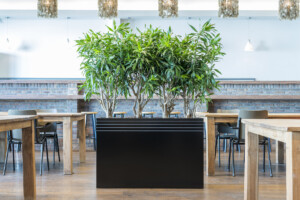
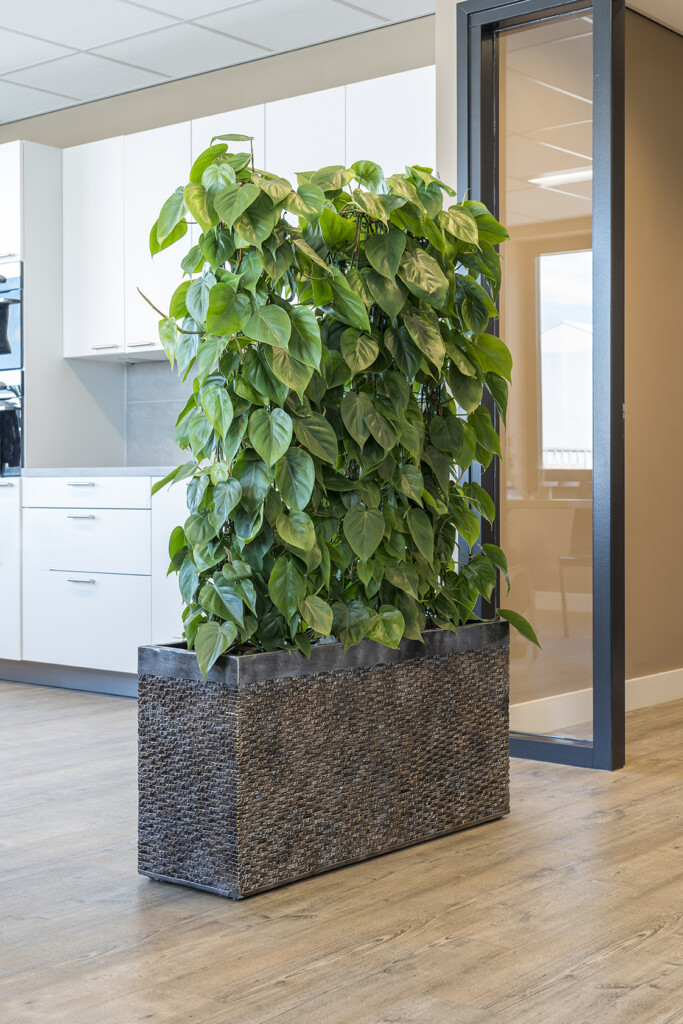
Our double-sided moss panel products make great healthy, physical floor standing and desktop barriers and come in a range of sizes to meet most workplace needs and dimensions. They are made with preserved moss, so they are low maintenance, meaning you will not need to take out an ongoing maintenance contract to keep them looking great. Simply dust them occasionally with a light feather duster and they will stay looking clean and vibrant.
The air we breathe
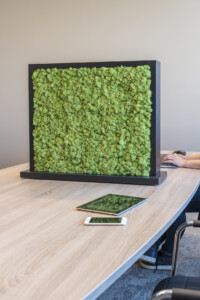
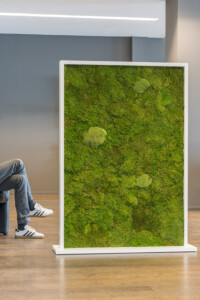
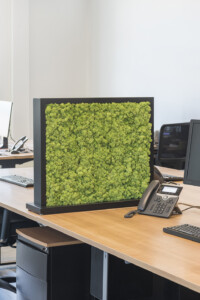
As we have mentioned in previous blog posts, plants and nature in general bring us many health benefits in our indoor spaces. Even our moss products, though not alive, are great for our mental wellbeing thanks to the biophilic benefits we get from views of nature. Biophilia is a big word for a simple concept: our innate need to stay connected to nature. Research has indicated that simply spending time in nature is beneficial for human health. In one study, people who spent just two hours per week interacting with nature reported greater levels of satisfaction and better general health than those who spent less time in natural environments. What’s more, spending time in natural environments is associated with improved mental and spiritual health among adults.
For many of us, the lockdown has highlighted the importance of taking care of our mental health: many have been struggling due to the impact of social distancing and working from home in isolation and we all have a part to play in creating a workplace culture that encourages good mental health practices. We’re not the only ones who think so: the World Economic Forum research into mental health at work suggests that employers need to create an environment in which we can “thrive physically and mentally”. It’s clear that this approach benefits employee and employer alike.
As well as all the biophilic benefits live plants bring to an indoor environment, they also improve indoor air quality. Even before the pandemic struck, there were plenty of reasons to be concerned about air quality and ventilation in the buildings where we live and work. After all, healthier indoor environments don’t just keep us from getting sick, they also enhance cognitive performance. To find out why it is more important than ever to work in a healthy building, read https://hbswk.hbs.edu/item/why-covid-19-raises-the-stakes-for-building-health.
Another area for consideration is the benefit of raising indoor air humidity. Plants increase humidity levels, due to transpiration: up to 99% of the water absorbed by a plant’s roots is lost via transpiration through the plant’s leaves. This in turn could be key in helping to limit the transmission of airborne respiratory droplets floating around in the air after an infected person coughs or sneezes. Higher humidity prevents a viral droplet from evaporating and reducing in size, meaning that it settles out of the air rapidly. In contrast to this, in low humidity, viral droplets evaporate rapidly, decrease in size and remain airborne for prolonged periods, increasing the time and distance over which transmission can occur. It’s important to stress that this theory has not been tested on Covid-19, although it has been previously proven by Dr Alan Evangelista (a microbiology and virology professor at St. Christopher’s Hospital for Children in Philadelphia) on other common coronaviruses and influenza particles. Dr Evangelista stresses that there are no guarantees that Covid-19 will behave exactly like these, but the laws of physics should apply in the same way.
Read more of Dr. Alan Evangelista’s interview here: https://abcnews.go.com/Health/humidity-stem-spread-coronavirus-early-specialist-hopeful/story?id=69624343
To illustrate how indoor humidity can impact the transmission of expiratory droplets between two people, the computer simulation below shows the difference between the size and spread of large expiratory droplets when in a drier atmosphere (on the left) vs a more humid one (on the right) over a 16 second period. Droplets in the drier atmosphere reduce in size and disperse more easily compared to droplets in a more humid atmosphere, where they remain larger and settle out.
Read more about this in the original article – Short-range airborne transmission of expiratory droplets between two people (Department of Mechanical Engineering, The University of Hong Kong & Department of Civil Engineering, Aalborg University, Aalborg SV, Denmark – June 2016)
Short-range airborne transmission of expiratory droplets between two people
A greater humidity also aids our immune system, by keeping our skin and mucous membranes healthier and more resistant to pathogens. Having a healthier mucous membrane in the throat also prevents dry throats and reduces coughing and a healthier mucous membrane in the nose prevents airborne particles and pathogens working their way into the nose, which makes us sneeze.
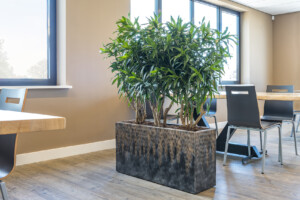
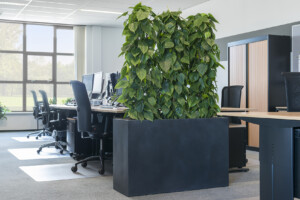
So, although we cannot state that plant and moss displays can protect you from Covid-19 in the workplace, they can be a very useful element in the workplace as part of wider solutions to help us to live and work alongside Covid-19 and can help us to maintain general good health at time when it matters more than ever. They form green, healthy physical barriers which simultaneously improve mental well-being, improve cognitive performance and increase humidity levels, that in turn not only reduce the spread of exhaled droplets, but also maintains a healthy mucus membrane, reducing coughing and sneezing and giving us better protection against airborne particles and pathogens. In fact, it is hard to find an argument to support not having plants as an integral part of the workplace and we may soon see innovation in planter design to accommodate hand sanitiser, paper towel dispensers etc, which could then be utilised at key locations within the workplace.
So, in conclusion, plant and moss displays can be a very useful element of the workplace to help us to live and work alongside Covid-19. They make ideal green, healthy physical barriers which simultaneously improve mental wellbeing, improve cognitive performance and increase humidity levels, that in turn not only reduces the spread of exhaled droplets, but also maintains a healthy mucus membrane, reducing coughing and sneezing and gives us better protection against airborne particles and pathogens. In fact, it is hard to find an argument to support not having plants as an integral part of the workplace and no doubt we will soon see innovation in planter design to accommodate hand sanitiser, paper towel dispensers etc, which could then be utilised at key locations within the workplace.
For more information, on how we can assist improve your existing planting, be it refreshing your displays or increasing and enhancing what you already have, then please get in touch and we will be delighted to assist, while observing safe and healthy working practices.
Workplaces have changed almost overnight in the wake of this pandemic: it’s time to find ways of moving forward in a way that keeps us safe and introduces healthier and happier working practices at the same time.
To help illustrate how plants can help, check out our infographic. Banner Infographic – Creating a healthy distance with plants
